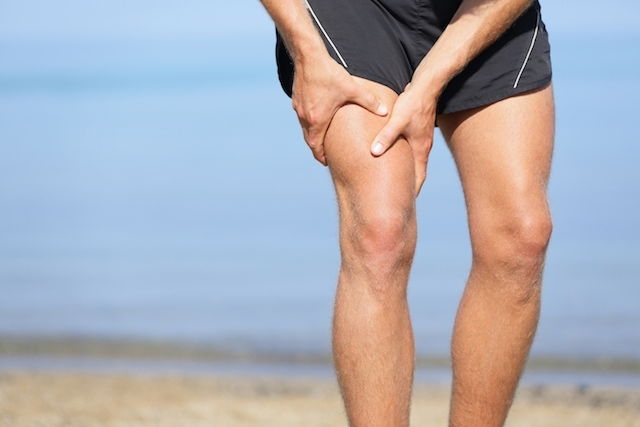Treatment for a pulled quad muscle can be carried out at home with simple measures such as rest, cold compresses and a compressive bandage. However, more serious cases may require medication and a few weeks of physiotherapy.
A pulled quad muscle is associated with a muscle strain. It occurs when the muscle over-stretches during physical activity, like working-out at the gym, running or playing sports. Learn more about what can cause a muscle strain.
A pulled quad muscle can cause symptoms like pain and limited movement. It can be classified into 3 different degrees, depending on the severity of the injury.

Check-out the following measures you can use to treat a pulled quad muscle at home:
1. Rest, ice and compression
The main measures for treating a pulled quad muscle include rest and applying ice. You should take a break from the gym or strenuous activity until the condition has improved. Total rest is not necessary, however, and you can maintain your routine activities, work, and school.
Within the first 48 hours of the injury or if swelling is present, you can apply a cold compress for 15 to 20 minutes, 3 to 4 times a day. After 48 hours or when swelling subsides, if there is no improvement, a warm compress can be placed on the muscle for 20 minutes at a time.
If the area continues to be swollen after the first 48 hours, as an alternative to a hot compress, you can use a compressive bandage around the thigh, which can help to reduce swelling.
2. Drainage
Drainage can beneficial if the quad muscle is swollen or bruised. Lymphatic drainage which can be performed at home by sliding a fine-toothed comb over the injury. If the pain and swelling is noted closer to the groin, slide the comb over the injury toward the groin. If the injury is felt closer to the knee, slide the comb towards the knee.
Another option is postural drainage, or elevating the leg, to help reduce swelling. You can also massage the area with creams or ointments containing camphor and menthol, which help to naturally relieve pain and swelling.
3. Use of medicines
Medications may be prescribed by the doctor if the pulled quad muscle produces pain that is persistent, or if the injury is the result of a muscle tear. In these cases, the doctor may recommend the use of non-steroidal anti-inflammatory medications or corticosteroid injections in some cases.
Also recommended: What Is Ibuprofen? 9 Uses, Side Effects & Contraindications tuasaude.com/en/what-is-ibuprofen4. Exercises
Light exercises and stretching can help to promote recovery. One easy way to promote blood flow to the muscle is to contract the muscle and then relax it about 10 to 20 times. Be sure to complete these movements slowly to prevent pain or discomfort.
Furthermore, you can stretch the muscle lightly, by extending your leg forward or bending your knee, pulling your heel toward your glutes. You can hold these stretches for a few seconds each, and perform them several times throughout the day.
5. Physiotherapy
Physiotherapy is typically recommended for more serious situations that are associated with a muscle tear. Exercises guided by a physiotherapist can help to promote healing and recovery. The physiotherapist may also employ other techniques, such as electrotherapy, ultrasound, laser therapy or TENS.
The physiotherapist must personally prescribe the treatment plan to be carried out, with ongoing monitoring and adjustments completed as necessary.
